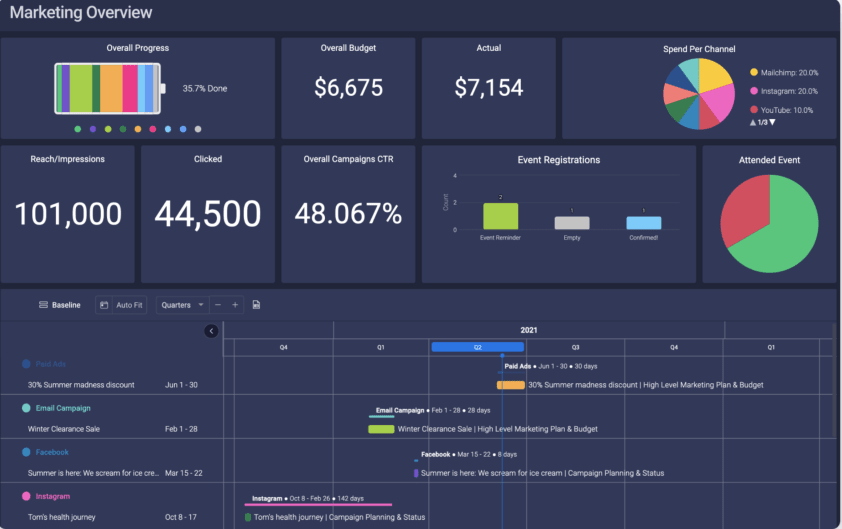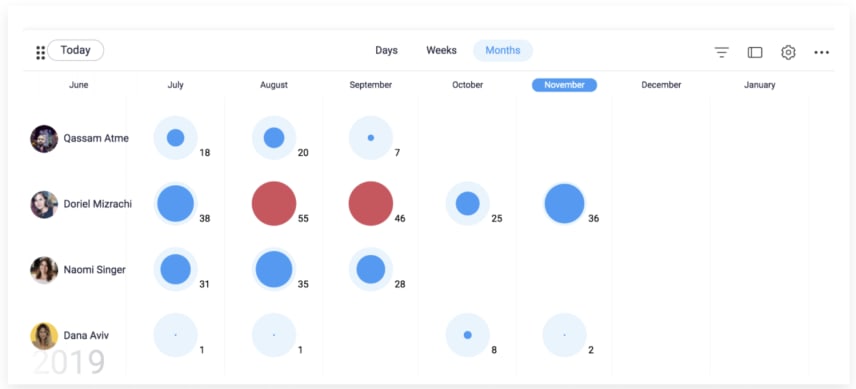When was the last time you assessed your marketing environment? Often, profit depends largely on marketing; people have to know you exist before they’ll drop a dime.
Your marketing strategy is everything you do as a business — how you present yourself, who you’re trying to reach, and what you do once you get their attention.
And the right strategy for you is dependent on the environment your business lives in.
This article will explore how to master environment marketing, how it influences your business, and show you some neat tricks for keeping your marketing team working together within it.

What is a marketing environment?
A marketing environment includes both the internal and external variables of a business’ marketing operations.
Internal variables include things like your team’s makeup, your customers, your stakeholders, as well as your distributors and partners.
External variables include the technological advancements of your industry, political or legal ramifications (GDPR, for instance) as well as social and economic changes (an economic recession or global pandemic, for instance).
Knowing your marketing environment is more than knowing your market. It’s understanding the forces that influence you, both inside and outside of your organization, to build a desirable product and get your message out to the world.As we mentioned above, a marketing environment is typically broken into internal and external factors.
Internal factors are in-house aspects under an organization’s control. External environmental factors are outside of a business’s control but can and do affect how a business functions.
Let’s take a closer look at each.
What’s included in an internal marketing environment?
Think of the internal marketing environment as the part that you can control — like the temperature in your office (vs the weather outside, which would be your external marketing environment).
For a quick snapshot of the internal marketing environment, consider the 5 M’s: Manpower, Materials, Machinery, Minutes, and Money
1. Manpower
Manpower means staffing. How many people do you have engaged in executing your marketing strategy? What are their roles? How are they managed? How do they collaborate?
2. Materials
Materials refer to marketing production. It can mean your marketing supply chain and the marketing assets that support your marketing strategy (like a branding style guide, flipbooks or Facebook ad templates). But materials can also refer to the products and services you are selling.
3. Machinery
Machinery means the systems used to assist you in your marketing activities. This can include your workspace and software, such as your CRM and digital marketing tools. It can even include your servers and hardware, and your phones and VoIP systems used in communications.
4. Minutes
Time is directly affected by your marketing planning, strategy, and processes. Like money, time is an asset. Get the most out of the time you have with efficient planning and automation platforms like monday.com.
5. Money
Your marketing budget and financial activities live here. While you may not have control over your marketing campaign budget itself, you do have control over how you use it. Companies that leverage marketing budget tools, like monday.com’s numbers widget, learn how to get the most from their budgets. In the dashboard below, this marketing team can see how much they spend per channel, their overall budget, reach/impressions, and a visual of which campaigns are running.

What’s included in an external marketing environment?
So now you’ve gotten a handle on your internal environment, time to move outside into the wilds. You had control inside, outside is more about rolling with the punches.
The external marketing environment is a lot like sailing. While you may not have control of the seas, you can read the weather, tack with the wind, and turn the bow of your ship to avoid any incoming waves.
We can break down the external marketing environment into a micro environment and macro environment.
What is the micro environment?
If the external environment overall is like sailing, then the micro-environment is sailing in bays and inlets. Nature still happens around you, but you’re more protected from it.
The parts of your external micro marketing environment (say that 5 times fast, I dare you) are your customers, your employees, suppliers, retailers, distributors, competitors, shareholders, and any other stakeholders.
Essentially this is everyone who shapes your company’s actions and policies in some way.
Let’s say you’re responsible for creating the marketing plan for the quarter:
- If your long-time competitor releases an integration with TikTok, all other things being equal, you should consider doing the same.
- If your supplier ups the price of server space, your profit margins are going to change, which could result in you needing to increase prices.
- If your customers express frustration over a new dashboard layout or UX change, you need to decide if you’re going to double down or revert.
Marketing teams need to keep the objectives of all stakeholders in mind when they set goals.
Despite being often overlooked, this includes employees. Your employees’ opinions, desires, and how they work has a direct impact on the success of any marketing project.
This can be especially difficult when dealing with remote teams.
Managing remote teams more transparently is easier with tools, like monday.com’s workload visualization (below), that let you visualize, in real time, how your remote staff is doing. This allows you to make adjustments to keep tasks balanced and prevent missed deadlines.

You can even keep your finger on the pulse of your staff’s opinions of changes and challenges so that they feel heard and nurtured. Employee willingness surveys can be easily created for any major internal change that may affect your marketing staff.
What is the macro environment?
The macro environment is the world we live in. Macro external factors can make a huge impact on your business in areas such as:
- Your demographic environment (your ideal customer persona), and the changes within that group
- Your cultural environment (for instance, if your target market is moving to TikTok over Snapchat)
- Political agendas (changes in trade, duties, regulations, taxes, etc)
- Your economic environment (like the Covid-19 epidemic or an economic or industry recession)
All of these can stop a business in its tracks.
But technological changes and innovation can just as easily lead to business growth.
For instance, monday.com Work OS can more than double your marketing campaign ROI. Just take a look at the following graphic from Forrester. After using monday.com for just a year, the Work OS saved 15,600 hours for the entire company and after three years, the company achieved a 288% ROI:

With monday.com, you can view and analyze all data from both external and internal environments, turn those insights into action, keep all work in a central location, and freely collaborate department and company wide. Here’s a short rundown of what teams can achieve with monday.com.
How monday.com can help you better understand your marketing environment factors
Keeping your marketing team on top of your business’ marketing environment means they have to be in contact with every part of your company and aware of news and trends.
Workflow platforms allow everyone to communicate smoothly within the context of their work, without needing to rely on the clutter of chat rooms or email. Plus, a robust Work OS plus stores all files, documents, projects, and tasks in one central, convenient location so everyone stays aligned.
For instance, monday.com Work OS enables you to customize a marketing project management design where you can assign tasks, plan campaigns, organize files, track deadlines, get instant project overviews, and more. When your internal or external marketing environments change, you can respond quickly and efficiently.
Smoothly manage your marketing operations with monday.com Work OS
When you know your marketing environment, you understand the world you are working in.
Marketing has always been about pivoting quickly and effectively to the world around (and within) your business.
And a Work OS will allow you to instantly shift gears when needed, adjust your strategy to market research, and keep all stakeholders in the loop.
Get started today with an easy-to-customize template from monday.com to bring your team together quickly within your market environment.
